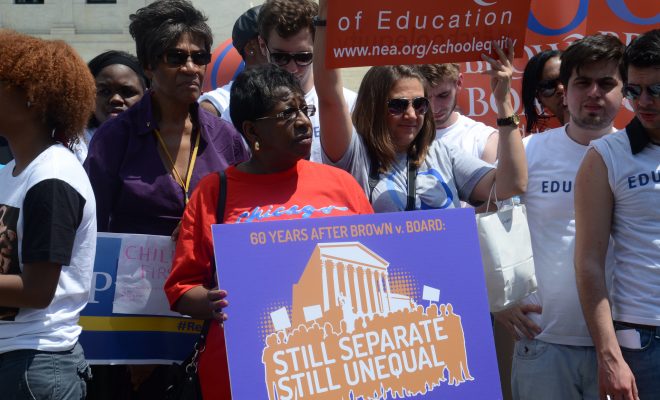 Image courtesy of [AFGE via Flickr]
Image courtesy of [AFGE via Flickr]
Education
How Can We Fix Racial Segregation In American Schools?
Martin Luther King Jr. once said that “the arc of the moral universe is long, but it bends towards justice.” That may be true, but it is not a smooth trajectory. Nor can you set society on the path to more justice and expect it to progress to your goal unsupervised. Creating a just society is not a one-time event. It is a constant process that requires continued maintenance.
More than 60 years after the landmark decision of Brown v. Board of Education we still face the challenge in the United States of ensuring that students of all races have the same access to a quality education. In many places, the gains that were made in the 1960s and 1970s have been eroded. In some places, it is as though no change took place at all.
Not only is segregated schooling contrary to our laws, it is contrary to our most deeply-held values as a nation of liberty and equity. And if neither the legal nor the moral argument persuade you that this should concern you, consider the self-interest argument. Because the children that we refuse to invest in today are the ones who will be unable to invest back into our society tomorrow.
All Deliberate Speed
This video is long, but if you are interested in a thoughtful discussion of the history of school integration and the challenges that we still face in making its promise a reality it is well worth watching.
Brown vs. Board of Education was in many ways a radical decision, and in some ways not radical enough. It refuted the earlier Supreme Court ruling of Plessy v. Ferguson, at least in the context of public education. In Plessy, the court had held that requiring black and white passengers to use separate accommodations on trains was not unconstitutional so long as the separate facilities were also equal. Thus the question became, in a discrimination case, a question of fact as to how the accommodations actually compared. Requiring black students to use facilities that were of markedly different quality wasn’t permissible, although in practice happened often, but if the facilities were equivalent then separate wasn’t discriminatory.
Brown changed this in the arena of public education. The rationale for opposing the segregation that existed was not merely because the resources provided to children of color were unequal–although that was the case and represented the primary, practical motivation for challenging the status quo–it was that having separate schools, even if those classrooms were identical, was inherently unequal. That separating American children based on race, even if all the other factors of their education remained the same, was in and of itself something that was damaging. In fact, evidence was produced to show psychological harm to black children from their segregated schooling. The practical effect for a school that could have been shown to be unequal in resources would have been the same with a Plessy standard. The school would have to be integrated or given more resources, the same way it would be forced to integrate under Brown. But in terms of what society was now willing to accept as equitable and just, Brown represented a profound change.
But Brown provided no roadmap for how to get from the world of 1954 into a modern, integrated society. And with the use of the now infamous phrase “all deliberate speed,” the court gave the societal forces who opposed integration ammunition in their fight to slow it down or halt it completely. Sixty years later there is still a backlash to integrating our schools.
Take a look at this video that highlights the situation in one town in Alabama that is still struggling with integration.
The Scope of the Problem
If you think that integration is a problem only in the South, think again. In the period from 1968 to 2011 school segregation actually increased in the Northeast–the percentage of black students in schools with at least 90 percent minority students went from 42.7 to 51.4 percent. In New York, 64.6 percent of black students go to a school that fits this definition of “hyper-segregation.”
If you attend a segregated school you are put at an immediate disadvantage, especially if you are a member of a minority group. You are segregated not only by race but also often by class, doubling down on the negative effects of growing up in a low-income neighborhood. Not only do you miss out on the social and cultural stimulation of meeting people who are different from you, you miss out on more tangible perks of a good school as well. Good teachers, good materials, and good courses aren’t on offer for you. The message is no less clearly received by children just because it is not said out loud: You don’t matter.
In contrast, a student who attends an integrated school is given an advantage over his or her segregated peers, whether they are black or white. If you are black and spent a year in a desegregated school your chance of graduating high school went up by 2 percent, for each year you attended that integrated school. If you spent five years in that integrated school your future wages rose by 15 percent, or an extra $5,900 in annual family income. You also are probably less likely to have a criminal record, since for minority boys the racial makeup of their school can have a significant impact on whether they commit a crime. A nonwhite boy in a school that has 60 percent minority students, versus 40 percent minority students, is 16 percent more likely to commit a crime.
Given that schools that have a high minority population are also, by every metric, of lower quality, it is not surprising that parents try to get their children in school elsewhere. Parents diligently research local schools when purchasing homes, take part in lottery systems, advocate for “freedom of choice” in schooling with voucher programs, push charter schools, and sue to resist integration attempts. This impulse is so strong among white parents in particular that even if two schools are equivalent in test scores white parents will opt for the school that has the “right” ratio of white and minority students. Apparently, you want a little diversity, but not too much.
In the midst of this, the Supreme Court ruled in 2007 that two school districts could not use race as a factor in assigning pupils to schools. Racial discrimination is not, according to Chief Justice Roberts, an answer to racial discrimination.
Political Will
If taking the race of an individual student isn’t the answer, what is? Take a look at this PBS NewsHour interview that strives to answer that question.
Professor Noguera argues that the situation that we see here–where poor, minority children are unable to break out of a cycle of segregation and poverty–is because of a lack of investment and a lack of political will. Our Nordic neighbors would definitely agree. In Finland, a country that is generally lauded as having the most successful education system in the world, decisions are made very differently.
In her book, “The Nordic Theory of Everything: In Search of a Better Life,” Anu Partanen explains the two different philosophical approaches to the question of education. The first approach is the “demand” approach. Education is an investment that parents are making in their children. And so to increase the quality of education you need to increase the demand for it made by those parents. Competition–charter schools, private schools, school choice vouchers etc.–will help to so this. In the United States many people, often Republicans but not exclusively so, support this theory. It allows parents to take the initiative to advocate for their children and to place them in the best possible circumstances.
Partanen’s critique of this approach is twofold. First, although parents are expected to make this investment they don’t directly benefit; it is the children and society at large who benefit from this investment–and not for 20 years or so. This may make the link between reward and investment tenuous for parents and perhaps discourage the investment. Which leads to the second, stronger criticism that it places all children at the mercy of their parents’ willingness and ability to invest in them. The most vulnerable children, children born to parents who do not have the means to invest financially in their education and/or do not have the inclination to do so, are just out of luck. Unless they happen to fall into a good school district, which is highly unlikely. Your entire academic fate rests on that first roll of the dice–who you were born to.
The Nordic Model
The alternate approach is the approach that holds sway in Finland and most other Nordic countries: the “supply” approach. Under this approach, education is viewed as the child’s right to receive an education, not the parent’s right to select the kind of education they want for their children. Because it is a right for the child, it is the government’s responsibility to supply the means to that education: high quality, equitable schools. Not the parents’ responsibility to demand it. While it by no means ensures an idyllic childhood for everyone it eliminates one of the principle vicissitudes of fortune, the quality of your education, that usually accompany your birth.
The keys to that approach being successful are having universally high-quality education, regardless of where the child is, and the decision by the government that a society as a whole is going to invest in its children. The fact that both of these are absent in the United States is what leads parents to play the game to get their children into predominately white public schools, or private schools, to give them the best shot of receiving a valuable education. In a society where all schools are excellent, there is no need to play that game. But because we do not practice what we preach–that all of our children are created equal–that society does not exist here.
The Gorilla In The Room
One problem with solving the issue of integration is that we have so far been unwilling to profoundly question how our schools are funded. School districts are largely funded with property taxes in that locality, so it creates a vicious circle of poverty and discrimination. Poor districts, with their disproportionate minority populations, raise less money than their wealthier and whiter counterparts. So they spend less per student, reducing the quality of education, and encouraging even more “white flight” from the area. Which, in turn, causes affluent parents in good school districts to turn a blind eye to the plight of other people’s children. Parents don’t feel that they need to worry about education and opportunity in a school their child doesn’t attend.
But whether they realize it or not, the middle class and the wealthy do have skin in the game. As both PBS video discussions make clear, these children may be other people’s children but they will not be someone else’s problem. They will be the workers who support social security in our old age. They will be the consumers acting as the engine of our economy. They will be the law-abiding citizens who participate in our democracy.
Or, because we did not invest in them, they won’t. And all Americans, not just those in the neighborhoods of these failing schools, will feel that burden.
Conclusion
The secret to America’s success is her dynamism and her diversity. We cannot be exactly like Finland, nor should we strive to be. But we are stopped from making reforms to our education, not by the things that make us different from Finland but by a lack of commitment to our own core values and a lack of political will. For example, rather than funding schools based on local property taxes a state could collect property taxes, pool them together, and divide the resources based on the number of students and student need as opposed to the accident of their geography. Another solution could be to reinstitute busing requirements for segregated districts. Or programs that encourage neighborhoods to not be so segregated in the first place.
These approaches may seem radical. And truthfully an overhaul of how schools are funded would be about as ambitious a project as one could undertake, politically and just logistically. But they are not radical if we decide that we are going to embrace the value of equity in our culture and treat education as something that every child, regardless of birth or circumstance, is entitled to. Not just because it is morally right in and of itself, although it is, but because our mutual investment in our children is to our mutual benefit.
Resources
Cornell Law School: Plessy v. Ferguson
Cornell Law School: Brown v. Board of Education
Slate: Brown v. Board of Education: On 60th Anniversary Schools Are Segregating
New York Times Magazine: Choosing a School For My Daughter in a Segregated City
Goodreads: Savage Inequalities
PBS: The Return of School Segregation in Eight Charts
The Washington Post: How Segregated Schools Turn Kids Into Criminals
Slate: When White Parents Have a Choice They Choose Segregated Schools
CQ Press: Racial Diversity In Public Schools
NPR: Supreme Court Quashes School Desegregation
Goodreads: The Nordic Theory of Everything: In Search of a Better Life
Goodreads: The Shame Of The Nation
Atlantic: The End of Busing in Indianapolis
PBS: A Return to School Segregation in America
USA Today: Still Apart: Map Shows States With Most-Segregated Schools








Comments